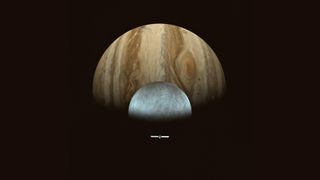Jupiter, the giant of our solar system, has always captivated astronomers and space enthusiasts. With NASA’s Europa Clipper mission underway, the spotlight is back on Jupiter and its fascinating moons, particularly Europa, a prime candidate in the search for life beyond Earth. But how many moons does Jupiter actually have? The answer is more complex than you might think.
Officially, the International Astronomical Union recognizes 95 moons orbiting Jupiter. However, the total number of natural satellites could be far greater.
The Galilean Moons: Jupiter’s Magnificent Four
The four most famous moons of Jupiter are the Galilean moons: Ganymede, Callisto, Io, and Europa. Discovered by Galileo Galilei in 1610, these moons are named after figures from Greek mythology associated with Zeus (the Greek equivalent of the Roman god Jupiter).
These are not just any moons. They are massive, comparable in size to Earth’s moon or even larger. Together, they account for about 99.997% of the total mass of all objects orbiting Jupiter. Their size allows them to sustain thin atmospheres and exhibit geological activity, like volcanism on Io.
- Ganymede: The largest moon in the solar system, even bigger than the planet Mercury.
- Callisto: Heavily cratered and the most distant of the Galilean moons.
- Io: The most volcanically active world in the solar system.
- Europa: Covered in a smooth layer of ice, thought to conceal a vast ocean, making it a prime target for astrobiological research.
 An illustration showing the Europa Clipper approaching Europa, with Jupiter perfectly aligned behind Europa in the background. Europa's icy surface is visible, and Jupiter looms large in the distance, emphasizing the scale of the mission and the Jovian system.
An illustration showing the Europa Clipper approaching Europa, with Jupiter perfectly aligned behind Europa in the background. Europa's icy surface is visible, and Jupiter looms large in the distance, emphasizing the scale of the mission and the Jovian system.
Beyond the Galilean Moons: A Multitude of Smaller Satellites
Beyond the Galilean giants, Jupiter boasts a vast collection of smaller moons. Each of Jupiter’s other official moons has a diameter greater than 0.6 mile (1 kilometer). While 57 of these moons have names, only eight have regular, nearly round orbits. According to Statia Cook, an astronomer at New York University, these smaller moons are “generally too small to hold onto any [atmospheric] vapor.”
In addition to the officially recognized moons, thousands of smaller “moonlets,” primarily captured asteroids and debris fragments, orbit Jupiter. These moonlets contribute to the complexity of the Jovian system.
Jupiter vs. Saturn: A Lunar Rivalry
For many years, Jupiter and its neighboring gas giant, Saturn, have competed for the title of “planet with the most moons.” The number of known moons has fluctuated as technology improves and new discoveries are made.
How Many Moons Does Saturn Have?
Currently, Saturn holds the lead with a confirmed 146 moons. This includes the massive Titan, which is truly exceptional. As Cook notes, “Titan is really special — it has clouds and rain, rivers and lakes — but made of hydrocarbons like methane instead of water.” Titan, along with Europa, is considered a top candidate for harboring extraterrestrial life within our solar system.
The Future of Lunar Exploration
Missions like Europa Clipper, scheduled to begin its investigation of Europa in 2030, and Dragonfly, destined for Titan in 2034, represent a significant step forward in understanding the potential for life beyond Earth. As Cook states, these missions are “an exciting step forward in our mission to investigate whether the conditions for life could exist beyond Earth, right here in our own solar system.”
